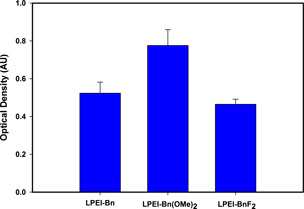Article contents
Bifunctional polyamines for the aqueous dispersion of carbon nanotubes and the formation of carbon nanotube-impregnated hydrogel composites
Published online by Cambridge University Press: 31 August 2011
Abstract

The extraordinary electronic, thermal, and mechanical properties of carbon nanotubes (CNTs) make them attractive materials for incorporation into polymer films. However, retaining these outstanding properties of CNTs during processing can be difficult due to the attractive forces that cause the nanotubes to bundle together. In this study, six different hydrophobically modified linear poly(ethylenimine) (LPEI) polymers are evaluated and effectively used as aqueous nanotube dispersants. This study also shows that the polymers are bifunctional in nature as aqueous polymer/nanotube mixtures can be cross-linked into CNT-impregnated hydrogels.
Information
- Type
- Rapid Communications
- Information
- Copyright
- Copyright © Materials Research Society 2011
References
1.Thess, A., Lee, R., Nikolaev, P., Dai, H.J., Petit, P., Robert, J., Xu, C.H., Lee, Y.H., Kim, S.G., Rinzler, A.G., Colbert, D.T., Scuseria, G.E., Tomanek, D., Fischer, J.E., and Smalley, R.E.: Crystalline ropes of metallic carbon nanotubes. Science 273, 437–438 (1996).CrossRefGoogle ScholarPubMed
2.Saleh, N.B., Pfefferle, L.D., and Elimelech, M.: Aggregation kinetics of multiwalled carbon nanotubes in aquatic systems: measurements nd environmental implications. Environ. Sci. Technol. 42, 7963–7969 (2008).CrossRefGoogle Scholar
3.Sano, M., Okamura, J., and Shinkai, S.: Colloidal nature of single-walled carbon nanotubes in electrolyte solution: the Schulze-Hardy rule. Langmuir 17, 7172–7173 (2001).CrossRefGoogle Scholar
4.Mitchell, C.A., Bahr, J.L., Arepalli, S., Tour, J.M., and Krishnamoorti, R.: Dispersion of functionalized carbon nanotubes in polystyrene. Macromolecules 35, 8825–8830 (2002).CrossRefGoogle Scholar
5.Coleman, J.N., Curran, S., Dalton, A.B., Davey, A.P., McCarthy, B., Blau, W., and Barklie, R.C.: Percolation-dominated conductivity in a conjugated-polymer-carbon-nanotube composite. Phys Rev. B 58, R7492–R7495 (1998).CrossRefGoogle Scholar
6.Hu, L., Hecht, D.S., and Gruner, G.: Carbon nanotube thin films: fabrication, properties, and applications. Chem. Rev. 110, 5790–5844 (2010).CrossRefGoogle ScholarPubMed
7.Karousis, N. and Tagmatarchis, N.: Current progress on the chemical modification of carbon nanotubes. Chem. Rev. 110, 5366 (2010).CrossRefGoogle ScholarPubMed
8.Kharisov, B.I., Kharissova, O.V., Gutierrez, H.L., and Mendez, U.O.: Recent advances on the soluble carbon nanotubes. Ind. Eng. Chem. Res. 48, 572 (2009).CrossRefGoogle Scholar
9.Lu, X., Detrembleur, C., Pagnoulle, C., Jerome, R., Bocharova, V., Kiriy, A., and Stamm, M.: Surface modification of multiwalled carbon nanotubes by poly(2-vinylpyridine): dispersion, selective depsotion, and decoration of the nanotubes. Adv. Mater. 16, 2123 (2004).Google Scholar
10.O'Connell, M.J., Boul, P., Ericson, L.M., Huffman, C., Wang, Y., Haroz, E., Kuper, C., Tour, J., Ausman, K.D., and Smalley, R.E.: Reverse water-solubilization of single-walled carbon nanotubes by polymer wrapping. Chem. Phys. Lett. 342, 265 (2001).CrossRefGoogle Scholar
11.Matarredona, O., Rhoads, H., Li, Z., Harwell, J.H., Balzano, L., and Resasco, D.E.: Dispersion of single-walled carbon nanotubes in aqueous solutions of the anionic surfactant NaDDBS. J. Phys. Chem. B 107, 13357 (2003).CrossRefGoogle Scholar
12.Islam, M.F., Rojas, E., Bergey, D.M., Johnson, A.T., and Yodh, A.G.: High weight fraction surfactant solubilization of single-wall carbon nanotubes in water. Nano Lett. 3, 269 (2003).CrossRefGoogle Scholar
13.Kojima, M., Chiba, T., Niishima, J., Higashi, T., Fukuda, T., Nakajima, Y., Kurosu, S., Hanajiri, T., Ishii, K., Maekawa, T., and Inoue, A.: Dispersion of single-walled carbon nanotubes modified with poly-l-tyrosine in water. Nanoscale Res. Lett. 6, 128 (2011).CrossRefGoogle ScholarPubMed
14.Backes, C., Mundloch, U., Ebel, A., Hauke, F., and Hirsch, A.: Dispersion of HiPco and CoMoCAT single-walled nanotubes (SWNTs) by water soluble pyrene derivatives—depletion of small diameter SWNTs. Chem. Eur. J. 16, 3314 (2010).Google ScholarPubMed
15.O'Connell, M.J., Boul, P., Ericson, L.M., Huffman, C., Wang, Y., Haroz, E., Kuper, C., Tour, J., Ausman, K.D., and Smalley, R.E.: Reversible water-solubilization of single-walled carbon nanotubes by polymer wrapping. Chem. Phys. Lett. 342, 265 (2001).CrossRefGoogle Scholar
16.Kang, Y. and Taton, T.A.: Micelle-encapsulated carbon nanotubes: a route to nanotube composites. J. Am. Chem. Soc. 125, 5650–5651 (2003).CrossRefGoogle ScholarPubMed
17.Sinani, V.A., Gheith, M.K., Yaroslavov, A.A., Rakhnyanskaya, A.A., Sun, K., Mamedov, A.A., Wicksted, J.P., and Kotov, N.A.: Aqueous dispersions of single-wall and multiwall carbon nanotubes with designed amphiphilic polycations. J. Am. Chem. Soc. 127, 3463–3472 (2005).CrossRefGoogle ScholarPubMed
18.Meredith, M.T., Glatzhofer, D., Kao, D.-Y., Schmidtke, D.W., and Hickey, D.: High current density ferrocene-modified linear poly(ethylenimine) bioanodes and their use in biofuel cells. J. Electrochem. Soc. 158, B166 (2011).CrossRefGoogle Scholar
19.Shim, M., Javey, A., Kam, N.W., and Dai, H.: Polymer functionalization for air-stable n-type carbon nanotube field-effect transistors. J. Am. Chem. Soc. 123, 11512–11513 (2001).CrossRefGoogle ScholarPubMed
20.Munoz, E., Suh, D.-S., Collins, S., Selvidge, M., Dalton, A.B., Kim, B.G., Razal, J.M., Ussery, G., Rinzler, A.G., Martinez, M.T., and Baughman, R.H.: Highly conducting carbon nanotube/polyethylenimine composite fibers. Adv. Mater. 17, 1064 (2005).CrossRefGoogle Scholar
21.Kokufuta, E., Suzuki, H., Yoshida, R., Yamada, K., Hirata, M., and Kaneko, F.: Role of hydrogen bonding and hydrophobic interaction in the volume collapse of a poly(ethylenimine) gel. Langmuir 14, 788–795 (1998).CrossRefGoogle Scholar
22.Ziebarth, J.D. and Wang, Y.: Understanding the protonation behavior of linear polyethylenimine in solutions through Monte Carlo simulations. Biomacromolecules 11, 29–38 (2010).CrossRefGoogle ScholarPubMed
23.Bencini, A., Bianchi, A., Garcia-Espana, E., Micheloni, M., and Ramirez, J.A.: Proton coordination by polyamine compounds in aqueous solution. Coord. Chem. Rev. 97–156 (1999).CrossRefGoogle Scholar
24.Smits, R.G., Koper, G.J.M., and Mandel, M.: The Influence of nearest-neighbor and next-nearest-neighbor interactions on the potentiometric titration of linear poly(ethylenimine). J. Phys. Chem. 97, 5745–5751 (1993).CrossRefGoogle Scholar
25.Tran, T.O., Lammert, E.G., Chen, J., Merchant, S.A., Brunski, D.B., Keay, J.C., Johnson, M.B., Glatzhofer, D.T., and Schmidtke, D.W.: Incorporation of single-walled carbon nanotubes into ferrocene-modified linear polyethylenimine redox polymer films. Langmuir 27, 6201 (2011).CrossRefGoogle ScholarPubMed
- 18
- Cited by

